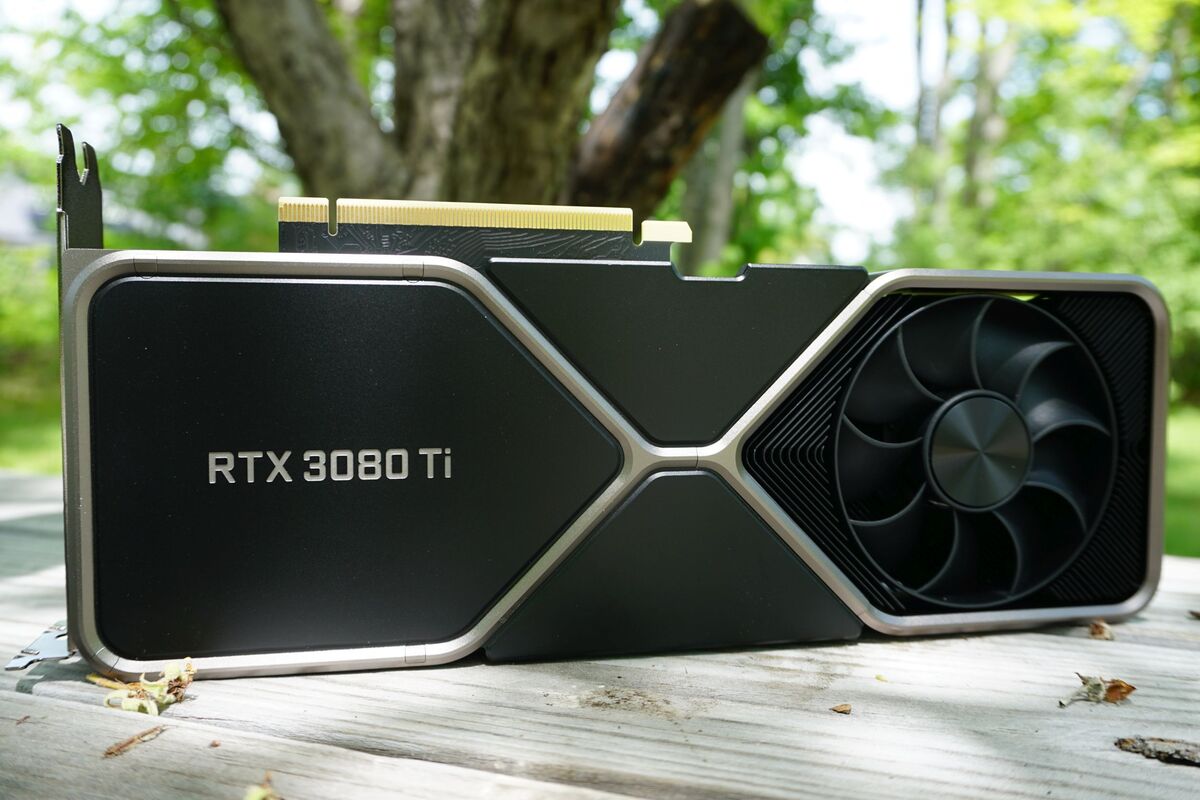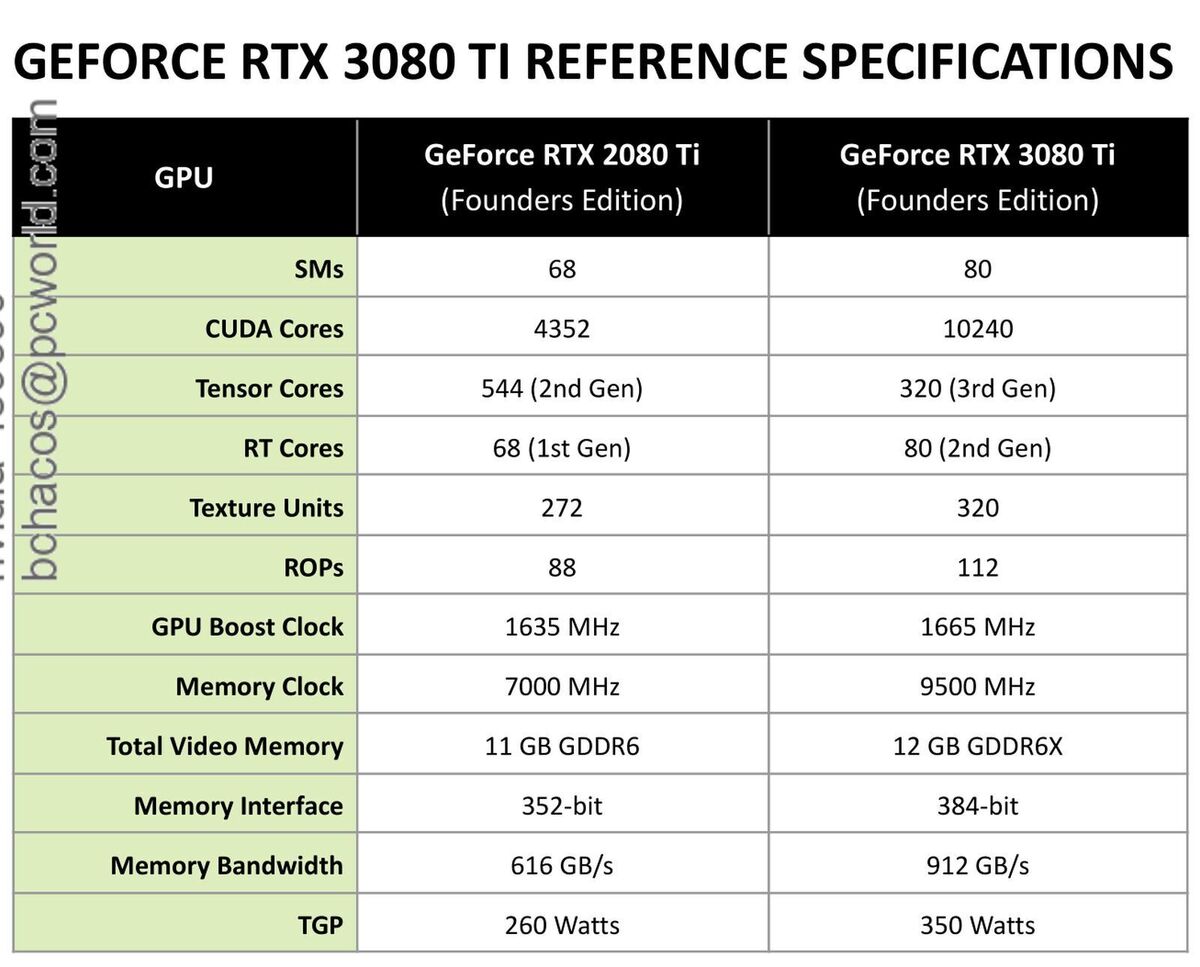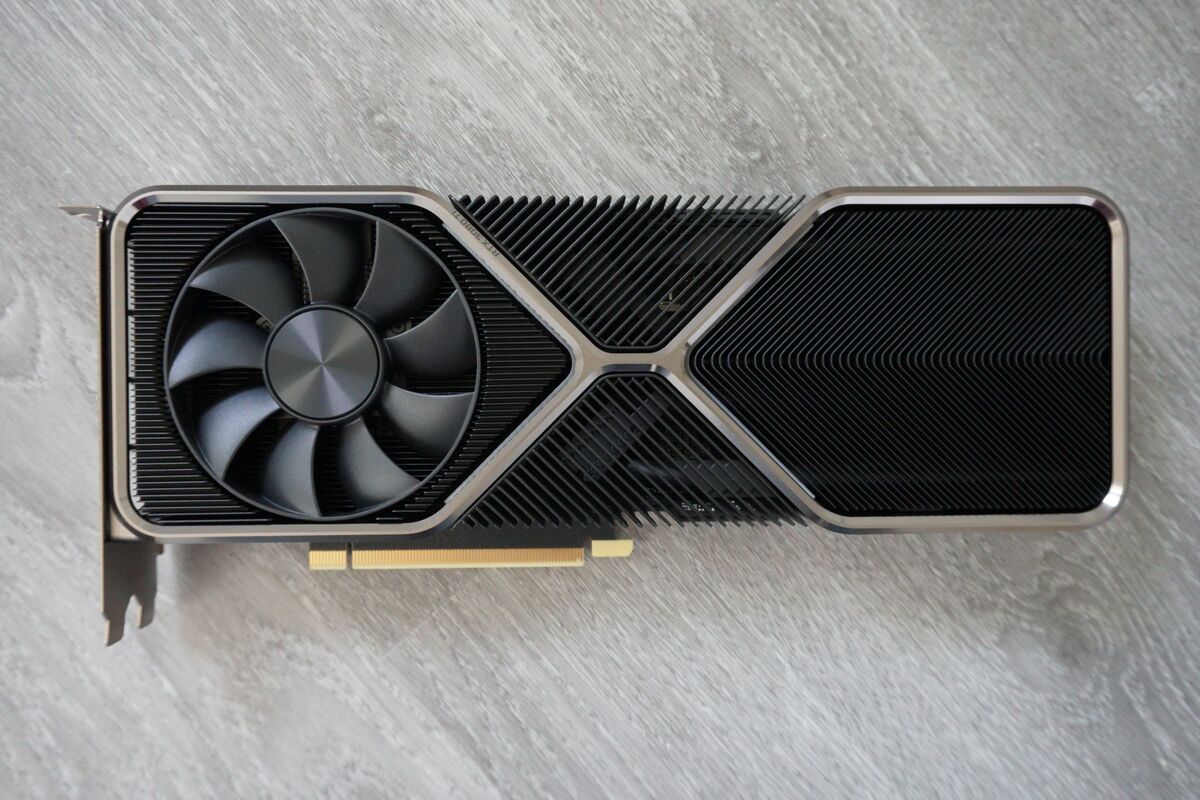Say hello to Nvidia’s “new gaming flagship.”

Brad Chacos/IDG
Today’s Best Tech Deals
Picked by PCWorld’s Editors
Top Deals On Great Products
Picked by Techconnect’s Editors
Nvidia GeForce RTX 3080 Ti Founders Edition
Show More
After months of endless leaks and rumors—many inaccurate—Nvidia’s $1,200 GeForce RTX 3080 Ti is finally here, and it’s an absolute monster. GeForce’s new “gaming flagship,” as Nvidia calls it, blazes through games almost as quickly as the ferocious GeForce RTX 3090. By halving the amount of ultra-fast GDDR6X memory to 12GB, this graphics card still packs more than enough VRAM to game at 4K resolution while clocking in at $300 less (though you’ll no doubt wind up paying more on the street, because graphics card pricing is insane right now).
It’s not all addition through subtraction, though. The GeForce RTX 3080 Ti weaves in performance-boosting PCIe Resizable BAR support in select titles, which Nvidia debuted after the launch of the original RTX 3080 in response to AMD’s rival Smart Access Memory. You’ll find Nvidia’s new “Lite Hash Rate” technology enabled as well, which cripples the card’s cryptocurrency mining performance. The RTX 3080 Ti also leverages Nvidia’s suite of truly killer software features, such as DLSS 2.0, the latency-reducing Nvidia Reflex API for esports games, Nvidia Broadcast’s AI-powered tools for streamers and video producers, the always-excellent NVENC encoder, and more.
This is the GeForce card that deep-pocketed gamers should buy, not the RTX 3090. But does Nvidia’s latest and (almost) greatest GPU pack enough of a punch to render AMD’s $1,000 Radeon RX 6900 XT obsolete? Let’s take Nvidia’s own GeForce RTX 3080 Ti Founders Edition to the test bench.
GeForce RTX 3080 Ti specs, features, and design
When you take a peek at the spec sheet it’s easy to see why the GeForce RTX 3080 Ti hits so hard. Under the hood, this GPU has much more in common with Nvidia’s work-hard, play-hard 3090 than the $700 RTX 3080 that shares its name. Nvidia says it’s also up to 1.5X faster than the RTX 2080 Ti that this card replaces.
 Nvidia
NvidiaThat’s a massive leap in power draw (TGP), though.
Because this “Ti” refresh builds upon the Nvidia Ampere GPUs that came before it in the RTX 30-series lineup, we won’t wade too deeply into details here, sticking largely to major differences. Our GeForce RTX 3080 review gets into Ampere’s nitty-gritty enhancements and tweaks.
The most important thing to look at is the CUDA core count, as that’s a key indicator of performance for Nvidia’s graphics cards. With a whopping 10,240 cores, the GeForce RTX 3080 Ti isn’t much of a cut-down GPU—the RTX 3090 has 10,496. By contrast, the RTX 3080 wields 8,704 CUDA cores. That alone should clue you in to how powerful the new 3080 Ti is. Our benchmarks will show it leaving the vanilla 3080 in the dust and landing right next to the 3090 in raw gaming performance.
And make no mistake: This is a proper gaming card, not a work/play hybrid like the RTX 3090. While that beast comes outfitted with a gargantuan 24GB of cutting-edge GDDR6X memory, the RTX 3080 Ti comes with a more gaming-appropriate 12GB over the same wide 384-bit bus. That gives the GPU a blistering 912GB/s of memory bandwidth, just behind the 3090’s 936GBps pace—more than enough for high-resolution gaming, especially when paired with so much memory capacity. The vanilla RTX 3080 offers a much lower (but fine!) 760GBps with its 10GB of GDDR6X and 320-bit bus.
 Brad Chacos/IDG
Brad Chacos/IDGAMD’s rival Radeon RX 6900 XT, on the other hand, packs in more raw capacity—16GB—but of the slower GDDR6 variety across a smaller 256-bit bus, so it only has an effectively memory bandwidth of 512GBps. That’s a bit deceiving though, as AMD’s RDNA 2 architecture includes a very high bandwidth “Infinity Cache” right on the GPU die itself that can handle many frame buffer tasks without needing to access the graphics card’s memory. Nvidia’s cards lack a similar feature and rely on the raw power of GDDR6X over a wider bus. In practice, however, all of these high-end GeForce and Radeon cards deliver plenty of bandwidth and performance for 4K gaming.
The GeForce RTX 3080 Ti Founders Edition physically resembles its vanilla 3080 FE counterpart more than the 3090, however. All RTX 30-series Founders Edition cards sport the same fundamental (and radical) design, with a “push-pull” configuration that features a blower-style fan at the rear paired with a second fan that pulls air through the card to exhaust heat upward into your case, where your CPU cooler and case fans can deal with it. (No, that doesn’t make your CPU run hotter.)
 Brad Chacos/IDG
Brad Chacos/IDGThe 12-pin connector is embedded in the metal fins on the side of the card and require using an included (ugly) 2x 8-pin connector.
They also include Nvidia’s new 12-pin power connector—an adapter to plug into a pair of traditional 8-pin connectors is found in the box—and a shroud design that’s absolutely bristling with thick metal fins that effectively turn the entire graphics card into a heat sink. It’s gorgeous.
 Brad Chacos/IDG
Brad Chacos/IDGYou’ll also find an HDMI 2.1 connection and a trio of DisplayPorts, each capable of handling 4K video feeds with ease. You won’t find extra features such as customizable RGB lighting, fan headers, or a dual-BIOS switch on FE cards, however.
Nvidia differentiates the RTX 3080 Ti from the RTX 3090 here as well, and potentially tossed its board partners a bone in the process. The Ti’s cooler comes in the same two-slot design as the original RTX 3080. Nvidia expanded the RTX 3090 to a chonky three-slot thickness, which fantastically tamed the monstrous GPU. Cramming the RTX 3080 Ti—which, again, is just a hair less powerful than the 3090—into the 3080’s dual-slot design results in higher temperatures than we see in either of the non-Ti models, and unlike the 3090, you can faintly hear the 3080 Ti working under full load. It’s still a fine cooler, and a good one at that, but if you want the best, you’ll still need to spring for the flagship—or for a premium third-party custom 3080 Ti with a beefier body and more cooling and power management technology inside.
 Brad Chacos/IDG
Brad Chacos/IDGThe RTX 3090 FE (left) is both much thicker and a bit longer than the RTX 3080 Ti FE (right).
Speaking of which, the GeForce RTX 3080 Ti also includes Nvidia’s “Lite Hash Rate” technology, which halves the effectiveness of mining the Ethereum cryptocurrency in half in a bid to free up GeForce stock for PC gamers during this unprecedented GPU shortage. The LHR tech is being built into all new GeForce GPUs except the 3090, as that luxury-priced graphics card is already intended to dominate at tasks that can make you money rather than simply amuse. Rumors ahead of the RTX 3080 Ti’s reveal whispered that Nvidia’s Founders Edition model specifically lacks the LHR limiter, but that’s not true. The FE card’s mining efficiency is just as nerfed as it is for third-party RTX 3080 Tis by the likes of EVGA, Asus, MSI, and so on.
Beyond that, the GeForce RTX 3080 Ti includes everything you get with all RTX 30-series GPUs: Best-in-class ray tracing, DLSS 2.0, Nvidia Reflex’s awesome latency lowering capabilities, the best-in-class NVENC encoder for streaming and video creation, and so on.
But enough chit-chat. Let’s get into how the GeForce RTX 3080 Ti compares against not just Nvidia’s other GPUs, but AMD’s shockingly potent Radeon RX 6900 XT.
Next page: Our test system, benchmarks begin
Nvidia GeForce RTX 3080 Ti Founders Edition
Nvidia’s GeForce RTX 3080 Ti is essentially an RTX 3090 in all but name (and memory capacity). It’s an exceptional graphics card for 4K gaming with no major weak links, but the Founders Edition cooler isn’t quite as impressive in this form and still needs an ugly power adapter. Actual price and availability remain a concern during the crippling worldwide GPU shortage.
Pros
- Excellent 4K and 1440p gaming
- 12GB of high-speed GDDR6X memory
- Best-in-class ray tracing, DLSS 2.0
- Nvidia software: Reflex, G-Sync, Shadowplay, Broadcast, RTX IO, DLSS
- Founders Edition design is gorgeous and effective
- PCIe 4.0, Resizable BAR, and Nvidia Lite Hash Rate tech
Cons
- Big price increase vs. prior xx80 Ti models
- Proprietary 12-pin power connector requires ugly adapter
- Actual price, availability in doubt due to GPU shortage
- Founders Edition design isn’t as effective as on other RTX 30 models, and lacks extra features

